User:Clockworklemon09/Murder of Julia Martha Thomas
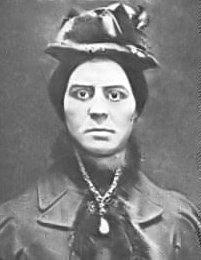
The murder of Julia Martha Thomas, dubbed the "Barnes Mystery" or the "Richmond Murder" by the press, was one of the most notorious crimes in late 19th-century Britain. Thomas, a widow in her 50s who lived in Richmond, was murdered on 2 March 1879 by her maid Kate Webster, a 30-year-old Irishwoman with a history of theft. Webster disposed of the body by dismembering it, boiling the flesh off the bones, and throwing most of the remains into the River Thames.
It was alleged, although never proven, that she had offered the fat to neighbours and street children as dripping and lard. Part of Thomas' remains were subsequently recovered from the river. Her severed head remained missing until October 2010, when the skull was found during building works being carried out for Sir David Attenborough.
After the murder, Webster posed as Thomas for two weeks, but was exposed and fled back to Ireland and her uncle's home at Killanne near Enniscorthy, County Wexford. She was arrested there on 29 March and was returned to London, where she stood trial at the Old Bailey in July 1879.
At the end of a six-day trial, she was convicted and sentenced to death after a jury of matrons rejected her last-minute attempt to avoid the death penalty by pleading pregnancy. She finally confessed to the murder the night before she was hanged, on 29 July at Wandsworth Prison. The case attracted huge public interest and was widely covered by the press in Great Britain and Ireland. Webster's behaviour after the crime and during the trial further increased the notoriety of the murder.
Background[编辑]

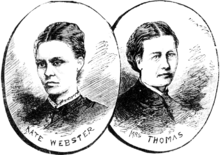
Julia Martha Thomas was a former schoolteacher who had been twice widowed. Since the death of her second husband in 1873, she had lived on her own at 2 Mayfield Cottages (also known as 2 Vine Cottages) in Park Road in Richmond. The house was a two-storey semi-detached villa built in grey stone with a garden at the front and back. The area was not heavily populated at the time, although her house was close to a public house called The Hole in the Wall.[1]
Thomas was described by her doctor George Henry Rudd as "a small, well-dressed lady" who was about fifty-four years old.[2] Elliot O'Donnell, summing up contemporary accounts in his introduction to a transcript of Webster's trial, said that Thomas had an "excitable temperament" and was regarded by her neighbours as eccentric. She frequently travelled, leaving her friends and relatives unaware of her whereabouts for weeks or months at a time.[3] She was a member of the lower middle class and as such was not wealthy, but she habitually dressed up and wore jewellery to give the impression of prosperity.[4] Her desire to employ a live-in domestic servant probably had as much to do with status as with practicality. However, she had a reputation for being a harsh employer and her irregular habits meant that she had difficulty finding and retaining servants. Before 1879, she had only been able to keep one maid for any length of time.[4]
On 29 January 1879, Thomas took on Kate Webster as her servant. Webster had been born as Kate Lawler in Killanne in County Wexford in about 1849. She was later described by The Daily Telegraph as "a tall, strongly-made woman of about 5英尺5英寸(165厘米) in height with sallow and much freckled complexion and large and prominent teeth."[3] The details of her early life are unclear, as many of her later autobiographical statements proved unreliable, but she claimed to have been married to a sea captain called Webster by whom she had four children.
According to her account, all of the children died, as did her husband, within a short time of each other. She was imprisoned for larceny in Wexford in December 1864, when she was only about 15 years old,[5] and came to England in 1867.[6] In February 1868, she was sentenced to four years of penal servitude for committing larceny in Liverpool.[7]
She was released from jail in January 1872 and, by 1873, she had moved to Rose Gardens in Hammersmith, West London, where she became friends with a neighbouring family named Porter.[8] On 18 April 1874, she gave birth to a son whom she named John W. Webster in Kingston upon Thames.[9] The identity of the father is unclear, as she named three different men at various times. One, a man named Strong, was her accomplice in further robberies and thefts. She later claimed to have been forced into crime, as she had been "forsaken by him, and committed crimes for the purpose of supporting myself and child".[10]
She moved frequently around West London using various aliases, including Webb, Webster, Gibbs, Gibbons, and Lawler. While living in Teddington, she was arrested and convicted in May 1875 of 36 charges of larceny. She was sentenced to eighteen months in Wandsworth Prison. Not long after leaving prison, she was arrested again for larceny and was sentenced to another twelve months' imprisonment in February 1877.[11] Her young son was cared for in her absence by Sarah Crease, a friend who worked as a charwoman for a Miss Loder in Richmond.[7]
In January 1879, Sarah Crease fell ill and Webster stood in for her as a temporary replacement at Loder's house. Loder knew Julia Martha Thomas as a friend and was aware of her wish to find a domestic servant. She recommended Webster on the basis of the latter's temporary work for her.[12] When Thomas met Webster, she engaged her on the spot, though she did not appear to have made any inquiries about Webster's character or past.[13] After Webster was taken on by Thomas, the relationship between the two women appears to have deteriorated rapidly. Thomas disliked the quality of Webster's work and frequently criticised it. Webster later said:
At first I thought her a nice old lady ... but I found her very trying, and she used to do many things to annoy me during my work. When I had finished my work in my rooms, she used to go over it again after me, and point out places where she said I did not clean, showing evidence of a nasty spirit towards me.[14]
Webster in turn became increasingly resentful of Thomas, to the point that Thomas attempted to persuade friends to stay with her as she did not like to be alone with Webster. It was arranged that Webster would leave Thomas' service on 28 February.[12] Thomas recorded her decision in her last diary entry: "Gave Katherine warning to leave".[15]
Murder and the disposal of the body[编辑]

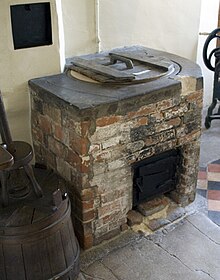
Webster persuaded Thomas to keep her on for a further three days until Sunday 2 March. She had Sunday afternoons off as a half-day and was expected to return in time to help Thomas prepare for evening service at the local Presbyterian church. On this occasion, however, Webster visited the local alehouse and returned late, delaying Thomas' departure. The two women quarrelled and several members of the congregation later reported that Thomas had appeared "very agitated" on arriving at the church.[12] She told a fellow congregant that she had been delayed by "the neglect of her servant to return home at the proper time", and said that Webster had "flown into a terrible passion" upon being rebuked.[16] Thomas returned home from church early, about 9 pm, and confronted Webster. According to Webster's eventual confession: The neighbours, a woman named Ives (who was Thomas' landlady) and her mother, heard a single thump like that of a chair falling over but paid no heed to it at the time.[17] Next door, Webster began disposing of the body by dismembering it and boiling it in the laundry copper and burning the bones in the hearth. She later described her actions: The neighbours noticed an unusual, unpleasant smell.[18] Webster spoke later of how she was "greatly overcome, both from the horrible sight before me and the smell".[19] However, the activity at 2 Mayfield Cottages did not seem to be out of the ordinary, as it was customary in many households for the washing to begin early on Monday morning.[18] Over the next couple of days, Webster continued to clean the house and Thomas' clothes and put on a show of normality for people who called for orders. Behind the scenes, she was packing Thomas' dismembered remains into a black Gladstone bag and a corded wooden bonnet-box.[20] She was unable to fit the murdered woman's head and one of the feet into the containers and disposed of them separately, throwing the foot onto a rubbish heap in Twickenham.[18] The head was buried under the Hole in the Wall pub's stables a short distance from Thomas' house, where it was found 131 years later.[21]
On 4 March, Webster travelled to Hammersmith to see her old neighbours the Porters, whom she had not seen for six years, wearing Thomas' silk dress and carrying a Gladstone bag which she had filled with some of Thomas' remains. Webster introduced herself to the Porters as "Mrs. Thomas". She claimed that, since last meeting the Porters, she had married, had a child, been widowed, and had been left a house in Richmond by an aunt. She invited Porter and his son Robert to the Oxford and Cambridge Arms pub in Barnes.[22] Along the way, she disposed of the bag that she was carrying, probably by dropping it into the River Thames, while the Porters were inside the pub drinking.[20] It was never recovered.[23] Webster then asked young Robert Porter if he could help her carry a heavy box from 2 Mayfield Cottages to the station. As they crossed Richmond Bridge, Webster dropped the box into the Thames. She was able to explain it away and did not arouse Robert's suspicions.[18]
The following day, however, the box was found washed up in shallow water next to the river bank about a mile downstream. It was spotted by Henry Wheatley, a coal porter who was driving his cart past Barnes Railway Bridge shortly before seven in the morning. He initially thought that the box might contain the proceeds of a burglary.[24] He recovered the box and opened it, finding that it contained what looked like body parts wrapped in brown paper.[25] The discovery was immediately reported to the police and the remains were examined by a doctor, who found that they consisted of the trunk (minus entrails) and legs (minus one foot) of a woman. The head was missing and was later assumed to have been thrown into the river separately by Webster.[26]
Around the same time, a human foot and ankle were found in Twickenham. It was clear that all of the remains belonged to the same corpse, but there was nothing to connect them with Thomas and no means to identify the remains.[18] The doctor who examined the body parts erroneously attributed them to "a young person with very dark hair".[25] An inquest on 10–11 March resulted in an open verdict on the cause of death,[27] and the unidentified remains were laid to rest in Barnes Cemetery on 19 March.[28] The newspapers dubbed the unexplained murder the "Barnes Mystery",[29] amid speculation that the body had been used for dissection and anatomical study.[25]
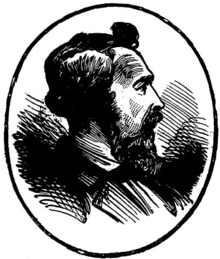
It was later alleged that Webster had offered two pots of lard to a neighbour, supposed to have been rendered from Thomas' boiled fat. However, no evidence about this was offered at the subsequent trial and it seems likely that the story is merely a legend, particularly as several versions of the story appear to exist.[26] The proprietress of a nearby pub claimed that Webster had visited her pub and tried to sell what she called "best dripping" there. Leonard Reginald Gribble, a writer on criminology, commented that "there is no acceptable evidence that such a repulsive sale was ever made, and it is more than possible that the episode belongs rightfully with the rest of the vast collection of apocryphal stories that has accumulated, not unnaturally, about the persons and deeds of famous criminals."[30]
Webster continued to live at 2 Mayfield Cottages while posing as Thomas, wearing her late employer's clothes and dealing with tradesmen under her newly assumed identity. On 9 March, she reached an agreement with John Church, a local publican, to sell Thomas' furniture and other goods to furnish his pub, the Rising Sun. He agreed to pay her £68 with an interim payment of £18 in advance.[31]
By the time that the removal vans arrived on 18 March, the neighbours were becoming increasingly suspicious, as they had not seen Thomas for nearly two weeks. Her next-door neighbour Miss Ives asked the deliverymen who had ordered the goods removed. They replied "Mrs. Thomas" and indicated Webster. Realising that she had been exposed, Webster fled immediately, catching a train to Liverpool and travelling from there to her family home at Enniscorthy.
Meanwhile, Church realised that he had been deceived. When he went through Thomas' clothes in the delivery van, he found a letter addressed to the real Thomas. The police were called in and searched 2 Mayfield Cottages. There they discovered blood stains, burned finger-bones in the hearth, and fatty deposits behind the copper, as well as a letter left by Webster giving her home address in Ireland. They immediately put out a "wanted" notice giving a description of Webster and her son.[32]
Scotland Yard detectives soon discovered that Webster had fled back to Ireland aboard a coal steamer in the company of her young son. The head constable of the Royal Irish Constabulary (RIC) in Wexford realised that the woman being sought by Scotland Yard was the same person whom his force had arrested 14 years previously for larceny. The RIC were able to trace her to her uncle's farm at Killanne near Enniscorthy[5] and arrested her there on 29 March.[28] She was taken to Kingstown (modern Dún Laoghaire) and from there back to Richmond via Holyhead, in the custody of the Scotland Yard men.[15]
On hearing of the crime with which she was charged, her uncle refused to give shelter to her son, and the authorities sent the boy to the local workhouse until such time as a place could be found for him in an industrial school.[15]
审判和处决韦伯斯特[编辑]
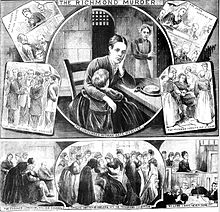
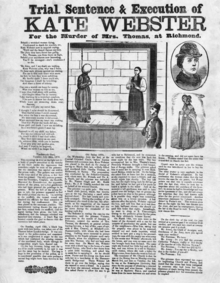
这起谋杀案在爱尔兰海两岸都引起了轰动。消息一经传出,许多人都前往里士满参观梅菲尔德别墅。[15] 这起犯罪事件在爱尔兰同样声名狼藉。韦伯斯特被捕后从恩尼斯科西被押送到都柏林的一路上,几乎每两地间的车站都会有成群的人围观,对她侧目而视、指指戳戳。[33]
《曼彻斯特卫报》写道,预审法官的听证会有“许多享有特权和好奇心的人......包括不少女士”出席。[34] 据《泰晤士报》报道,韦伯斯特在里士满地方法院的首次出庭广受关注:“昨日,法院门口人头攒动......群情激愤溢于言表。”[35]
1879年7月2日,韦伯斯特在有“老贝利”之称的中央刑事法庭受审。这起案子唤起了公众极大兴趣,控方由英格兰与威尔士律政司哈丁·吉法德爵士领衔,韦伯斯特的辩护律师是伦敦著名律师沃纳 · 斯利,案子则由丹曼法官先生主持。[36] 与之前在里士满的听证会一样,这次审判出席率相当高,且吸引了社会各个阶级。在审判第四日,瑞典王储、也就是未来的国王古斯塔夫五世出席了听证会。[37]
在六天时间里,法庭听取了若干证人对托马斯遇害的复杂故事的拼凑。 在受审前,韦伯斯特曾试图指控酒馆老板约翰·丘奇和她从前的邻居波特与此案有牵连,但两人都有可靠的不在场证明,与谋杀案洗清了干系。[38] 她拒不认罪,而她的辩护律师试图强调证据的旁证性质,并强调她对自己儿子的献身精神正是她不可能犯下谋杀罪的原因。[39] 然而,韦伯斯特给大众留下的恶劣印象、冷血的举止和无力的辩护,使天平朝着相反的方向强烈倾斜。[38]
一位名叫玛丽亚·德登的鞋匠抛出了一条格外致命的证据,她向法庭证明,谋杀案发生一周前韦伯斯特曾拜访她,说自己要去伯明翰变卖一些家产、首饰和一处姑母遗留的房产。陪审团将此视为韦伯斯特预谋杀人的证据,[40]经过一个小时一刻钟的商讨后宣告她有罪。[41]
陪审团做出裁决后不久,就在法官即将宣判前,韦伯斯特被问到是否有任何理由不对她宣判死刑。 她声称自己正怀孕,而这显而易见是为了逃避死刑。 [42]《法律时报》报道称,“这随即带来的是一片未知,假如称不上是混乱。进而,这绝对与这样的场合应有的肃穆所不相衬。”法官给出的意见是,“从业三十二年来,他从未进行过这类调查。"
最后,阿西兹书记官建议本案采用女性陪审团的古老机制,从出席法庭的女性中挑选人员,对韦伯斯特是否“有胎动”的问题进行裁决。十二名女性和一名叫做邦德的外科医生一同宣誓后,陪同韦伯斯特来到一个私密房间进行检查。检查仅仅进行了几分钟时间,结论是韦伯斯特并没有“有胎动”,尽管如此,这并不意味着她肯定没有怀孕——这一分歧的存在,出于伦敦产科协会主席反对使用“没出生的孩子在所谓胎动之前就不算是个生命这套跟不上时代的医学假设”。
在处决韦伯斯特的几天前,一则上诉以她的名义向内政大臣R.A.克罗斯递交,但随即遭到拒绝。官方声明称,考虑到之前的争论,内政大臣“找不到足够依据建议女王陛下干涉法律的正当过程。”
在受到处决前,韦伯斯特做了两则声明,承认了自己的罪行。在她的第一则声明中,据说是孩子父亲的斯特朗被牵涉到了谋杀案中,她说是他把自己送上了犯罪生涯,他应该对此负责。但在7月28日,也就是她应该被处决的前夜,她又宣称撤回这一指控,进一步声明自己应该为谋杀负全责,丘奇、波特、斯特朗都与此毫无干系。次日清晨9点,她在旺兹沃思监狱接受了绞刑。刽子手威廉·马尔伍德采用了最新发明的长距离技术,使她刹那间一命呜呼。在她的死亡得到确认后,韦伯斯特被葬于监狱一块活动场地的无名坟墓中。当已执行死刑的黑旗自监狱墙头升起,等待在外的民众掌声雷动。
处决韦伯斯特的第二天,托马斯的财产在梅菲尔德农舍举行拍卖。酒馆老板丘奇最终还是设法弄到了托马斯的家具和她的一些私人用品,其中包括她的怀表,甚至还有韦伯斯特用来肢解她的那把小刀。韦伯斯特烹煮过托马斯的尸体碎块的铜器,则以五先令的价格售出。拍卖会上的其他人从农舍摘走了不少小鹅卵石和树枝当作纪念品,好让自己不虚此行。农舍在1897年之前始终处于闲置状态,毕竟在凶杀案后没人想住进这一凶宅。据房主说,佣人们甚至也拒绝在这个声名狼藉的地方工作。
后来,传说可以看到一个“幽灵修女”反复徘徊在埋葬托马斯的地方。令埃利奥特·奥唐纳既感惊讶又感失望的是,没有任何迹象指明她的房子闹鬼,盖伊·洛根注意到在“整洁而漂亮”的外观下,没有人能看出里面曾经发生过何等罪行:“这很难想象。这里看上去不像是一般出过人命的地方。”
谋杀案的社会效应[编辑]

在维多利亚时代的英国和爱尔兰,这起谋杀案都产生了相当大的社会影响。此事发生后,立即引起了轰动,并在报刊上广泛报道。在都柏林,《自由人杂志》和《每日商业广告》指出,这是“对人类恶行的记载中最耸人听闻的一页”,以致关于此案的报道“充斥着令人毛骨悚然的描述与细节”。
在韦伯斯特被捕仅仅几周内,也就是在她受审之前,杜莎夫人就制造了她的蜡像,展览给想要一睹“里士满女杀人犯”模样的人们,可见其恶名之远扬。直到二十世纪,她的蜡像依然完好无损地对外展出,和她摆放在一起的则是其他臭名昭著的杀人犯,诸如伯克和海尔、克里平医生。
在对韦伯斯特执行死刑的那几天,斯特兰德街上一家出版社别出心裁,印刷了名为《凯特·韦伯斯特的生平、审判与处决》的小纪念册,以一便士的价格出售。纪念册共二十页,印刷精良,包含了韦伯斯特的完整个人史,包括对此的总结、裁决和有趣的细节,连同她的遗言,还有一整页关于死刑执行的雕刻、肖像的插图。《警方新闻图册》发布了纪念封面,由艺术家刻画了关于死刑执行当天的印象。画中描绘了“友人探视”“捆绑过程”,终极仪式为“黑旗升起”,而最后则是“石灰盖棺”。
在案件还在审判时,街头民谣也以此为题材进行创造。这类民谣借用流行歌曲的曲调,以音乐作为叙事形式。就在凯特·韦伯斯特被捕后不久,萨瑟克区的印刷和出版商 H.苏奇 就发行了一首民谣,名为《那个家住巴恩斯附近的老太太死无全尸》,他采用的曲调是美国南北战争时期的著名歌曲《战斗前夕,母亲》。对韦伯斯特的审判结束时,苏奇发表了另一首民谣,以《被赶出家门》为曲调,他写道:
里士满的凶案,又在舞台上演
韦伯斯特的故事,写到最后一篇
她死有余辜,只因铁证已如山
她插翅难飞,挣不脱法律的铁腕!
她谎话连篇,在这凶案中
百般狡辩,却无一得逞
诡计多端,还想嫁祸于人
但事到如今,她的结局已定!
韦伯斯特其人被塑造为一个恶毒、不择手段、肆意作恶的魔鬼。在评述者看来,她的罪行可怖且可耻。为人佣仆者应谨守规矩,她对雇主的极度暴行令人深感不安。在当时,百分四十的女性劳动力都是家庭女佣,受雇于社会各阶层,从最富裕的家庭到体面的工人阶级家庭。主人和佣人起居、工作的地方非常相近,佣人的忠诚和规矩是一个经久不衰的话题。在那时,佣人的薪资很低,时时诱惑她们产生盗窃的冲动。如果韦伯斯特成功向约翰·丘奇出售了托马斯的家具,她就可以得到相当于两三年薪水的收入。
韦伯斯特受到强烈谴责的另一个原因则是她试图冒充托马斯。她曾在两周内成功扮成了托马斯的模样,意味着中产阶级身份不过是得体的举止、合适的服饰与适量的财产,无论这些是不是自己挣来的。韦伯斯特曾想要嫁祸的老板约翰·丘奇,曾经就是一名佣人,但他成为了初等的中产阶级,获取了一定财富,也将小酒馆经营得井井有条。他致力于努力工作提高生活水平,这符合当时的道德观。与之相比,韦伯斯特只是简单粗暴地窃取了她暂时拥有的中产阶级身份。
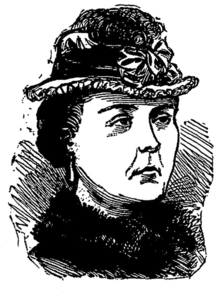
在维多利亚时代的许多民众心中,加深了韦伯斯特的罪行的是她颠覆了那个时代所期望的女性标准。在维多利亚时代的理念中,女人品行完备、循规蹈矩、身体柔弱或深受约束。韦伯斯特简直就是这一切的对立面,对于她的报道都竭尽描述她缺乏女性气质的一面。埃利奥特·奥唐奈在庭审记录的序言中对她进行了这样的描述:“岂止野蛮,野蛮到令人发指......更把人性的残酷无情发挥到淋漓尽致,邪恶凶残到无与伦比,简直非人哉!”报纸形容她“形容枯槁,令人憎恶,带着丧家之相”,然而就《便士插图报和时代画报》的记者所言,她“并不像描述中那样不堪入目”。
韦伯斯特的外形和言行被看作是她本性罪恶的关键标志。在人们的认知中,社会底层的“渣滓”会犯罪,且自甘堕落为“惯犯”,他们宁愿选择过一种酗酒和偷窃的生活,也不愿通过节俭和努力工作来提高自己。韦伯斯特强壮的体格尽管有部分原因是由于她靠辛苦的体力劳动谋生,却与广大中产阶级心中女性注定柔弱的观念背道而驰。一些人把她的面目特征就评价为面带凶相。奥唐奈对她的评价是“有双斜眼”,而他声称“在凶杀案中这种面相不少......在我看来她的这个特征本身就是一种天然的危险信号,警告人们要躲她远点。”
韦伯斯特在法庭上的表现和她的性经历也对她非常不利。记者普遍形容她面对庭审的态度为“冷静”和“不动声色”,只在提到儿子时哭了一次。在人们的期望中,女人在这样的情境下应该情绪化而悔不当初,可她的行为不符合这种“合理的女性气质”。她的一串男性朋友(其中之一还与她在未婚状态下有了孩子),似乎可以证明她堪称糜乱的性欲与性生活——这再次与人们预期中的女性行为准则抵触。在受审期间,她指责潜在的儿子父亲斯特朗将自己引入歧途,试图借此为自己换取同情,但她失败了。她的指控是:“我和一个本应保护我的人关系亲密,却遇人不淑,结果自己也和他们狼狈为奸。”这种说法利用的正是一种普遍社会预期,即女性的道德意识与贞操密不可分——在性方面的“堕落”会带来另一种形式的“自毁”——和女人发生过性关系的男人也因此有了某种社会义务。韦伯斯特试图把三个无辜的男人卷进此案同样犯了众怒,奥唐奈评论道:“公众舆论作为一个整体,对凯特·韦伯斯特试图拉三个无辜者上刑场这一行为的谴责程度,和对谋杀案本身的愤慨一般无异。”
据女性犯罪研究网络的沙尼·德克鲁兹所言,韦伯斯特是爱尔兰人这一事实也是她在大不列颠受到普遍厌恶德重要因素。自1849年大饥荒后,很多爱尔兰移民到了英格兰,但却遭遇了广泛的偏见,在顽固的地域刻板印象中,他们都有酗酒和偷盗的毛病,更有甚者将爱尔兰人刻画为野兽、野蛮人。爱尔兰和英格兰工人之间暴力冲突不断,在英格兰的芬尼亚人(爱尔兰民族主义者)也频频发起攻击。奥唐奈对韦伯斯特“非人哉”的描述,实际上与公众与司法界认为爱尔兰人先天就是罪犯的看法一致。
发现托马斯的头骨[编辑]
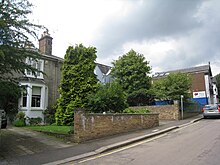
1952年,博物学家大卫·艾登堡和他的妻子简买下了一所位于之前梅菲尔德村舍所在地(现在仍然存在)和墙洞酒馆之间的房子。[43] 酒吧于2007年关闭,陷入废弃,但2009年被爱登堡收购并重新开发。[44]
2010年10月22日,工人在老酒馆后面进行挖掘工作时,挖出了一个“黑黝黝的圆形物体”,结果发现一个妇女的头骨。 它被埋在至少有40年历史的地基下面,就在酒馆的马厩原址上。 人们立即猜测,这块头骨是茱莉亚 · 玛莎 · 托马斯失踪的头颅,验尸官要求里士满警方对头骨主人的身份和死亡情况进行调查。[45]
爱丁堡大学的碳年代测定结果表明,这块头骨的年代可以追溯到1650年至1880年之间,而事实上,这块头骨是沉积在一块维多利亚时代的瓷砖上的,这表明它属于那个时代末期。 头骨上有骨折的痕迹,符合韦伯斯特把托马斯扔下楼梯的说法。而且头骨胶原含量很低,显然是因为曾被煮过。 2011年7月,验尸官得出结论,这个头骨确实属于托马斯。尽管不存在 DNA 测试的可能,因为她死时没有孩子,也找不到任何亲属;此外,也没有任何关于她身体其余部分埋葬地点的记录。[21]
2011年8月24日,这块头骨被埋葬在里士满公墓的一个无名墓穴中。
验尸官留下了非法杀人的判决记录,更替了1879年的公开判决。 托马斯的死因被判定为窒息和头部外伤。 警方称这一结果是“一个很好的案例,说明了老式侦探工作、历史记录和技术进步如何结合解决‘巴恩斯之谜’。”[46]
参考资料[编辑]
- ^ O'Donnell 1925,第13頁.
- ^ Rudd 1916,第84頁.
- ^ 3.0 3.1 O'Donnell 1925,第10頁.
- ^ 4.0 4.1 O'Donnell 1925,第14頁.
- ^ 5.0 5.1 "The Barnes Mystery". Lloyd's Weekly Newspaper. London, England. 30 March 1879.
- ^ O'Donnell 1925,第58頁.
- ^ 7.0 7.1 Wilson 1971,第193頁.
- ^ O'Donnell 1925,第7頁.
- ^ "The Barnes Mystery". The Belfast News-Letter. Belfast, Ireland. 2 April 1879. p. 5.
- ^ O'Donnell 1925,第8頁.
- ^ O'Donnell 1925,第9頁.
- ^ 12.0 12.1 12.2 Wilson 1971,第194頁.
- ^ O'Donnell 1925,第15頁.
- ^ O'Donnell 1925,第19頁.
- ^ 15.0 15.1 15.2 15.3 "里士满谋杀指控"。 泰晤士报》。 伦敦。 1879年3月31日。 3月11日。
- ^ O'Donnell 1925,第23頁.
- ^ D'Cruze, Walklate & Pegg 2006,第53頁.
- ^ 18.0 18.1 18.2 18.3 18.4 Rudd 1916,第87頁.
- ^ O'Donnell 1925,第68頁.
- ^ 20.0 20.1 Rudd 1916,第89頁.
- ^ 21.0 21.1 "Head found in David Attenborough's garden was murder victim". The Daily Telegraph. 5 July 2011. Retrieved 22 July 2011.
- ^ O'Donnell 1925,第33頁.
- ^ Rudd 1916,第95頁.
- ^ "Untitled article". The Manchester Guardian. Manchester, England. 10 March 1879. p. 5.
- ^ 25.0 25.1 25.2 "Supposed Murders". The Times. 11 March 1879. p. 5.
- ^ 26.0 26.1 Wilson 1971,第195頁.
- ^ "The Barnes Mystery". Lloyd's Weekly Newspaper. 23 March 1879. p. 8.
- ^ 28.0 28.1 "The Barnes Mystery". The Manchester Guardian. 30 March 1879. p. 6.
- ^ Rudd 1916,第83頁.
- ^ Gribble 1957,第69頁.
- ^ Wilson 1971,第196頁.
- ^ "The Barnes Mystery". The Manchester Guardian. 27 March 1879. p. 7.
- ^ "巴恩斯之谜"。 弗里曼杂志和每日商业广告。 爱尔兰都柏林。 1879年3月31日。
- ^ "里士满谋杀案"。 曼彻斯特卫报。 1879年4月10日。 十月六日。
- ^ 《里士满谋杀案》。 泰晤士报》。 1879年4月1日。 十月五日。
- ^ Gaute & Odell 1983,第87頁.
- ^ "里士满谋杀案"。 曼彻斯特卫报。 1879年7月6日。 十月六日。
- ^ 38.0 38.1 D'Cruze, Walklate & Pegg 2006,第55頁.
- ^ Conley 2006,第84–5頁.
- ^ Wilson 1971,第198頁.
- ^ Rudd 1916,第97頁.
- ^ Rudd 1916,第98頁.
- ^ Smith, Giles (31 December 2001). "What comes naturally". The Daily Telegraph. London. Retrieved 22 July 2011.
- ^ Powell, Laura (1 June 2009). "Sir David foils developers – by buying the pub next door". The Daily Mail. London. Retrieved 22 July 2011.
- ^ Fleming, Christine (26 October 2010). "Inquest opens into skull found in Sir David Attenborough's garden". Richmond and Twickenham Times. Richmond. Retrieved 22 July 2011.
- ^ "'Barnes mystery' of Attenborough garden skull solved". BBC News. 5 July 2011. Retrieved 22 July 2011.
引用错误:在<references>标签中name属性为“Police News 2 Aug 1879 p4”的参考文献没有在文中使用
引用错误:在<references>标签中name属性为“Lloyd's 3 Aug 1879”的参考文献没有在文中使用
引用错误:在<references>标签中name属性为“Miller 1986 p66”的参考文献没有在文中使用
引用错误:在<references>标签中name属性为“Police News 9 Aug 1879”的参考文献没有在文中使用
引用错误:在<references>标签中name属性为“Police News 2 Aug 1879 p1”的参考文献没有在文中使用
引用错误:在<references>标签中name属性为“H. Such @Apr 1879”的参考文献没有在文中使用
引用错误:在<references>标签中name属性为“H. Such Jul 1879”的参考文献没有在文中使用
参考书目[编辑]
- Bailey, Brian J. Hangman: from Ketch to Pierrepoint, 300 years of execution. London: True Crime. 1993. ISBN 978-0-86369-623-7.
- Carver, Stephen James. The life and works of the Lancashire novelist William Harrison Ainsworth, 1850–1882. Lewiston, NY: Edwin Mellen Press. 2003. ISBN 978-0-7734-6633-3.
- Castleden, Rodney. Serial Killers: They Live to Kill. London: Time Warner. 2005. ISBN 978-0-316-73252-9.
- Conley, Carolyn. Certain other countries: homicide, gender, and national identity in late nineteenth-century England, Ireland, Scotland, and Wales. Columbus, OH: Ohio State University Press. 2006. ISBN 978-0-8142-1051-2.
- D'Cruze, Shani; Walklate, Sandra; Pegg, Samantha. Murder: Social and historical approaches to understanding murder and murderers. Cullompton, Devon: Willan Publishing. 2006. ISBN 978-1-84392-169-1.
- Gaute, J.H.H.; Odell, Robin. Lady Killers. Bath, England: Chivers Press. 1983: 83. ISBN 978-0-85119-885-9.
- Gribble, Leonard Reginald. Famous judges and their trials: a century of justice. London: J. Long. 1957.
- O'Donnell, Elliot. The Trial of Kate Webster. Edinburgh: William Hodge & Company. 1925.
- Oldman, James. Trial by jury: the Seventh Amendment and Anglo-American special juries. New York: NYU Press. 2006. ISBN 978-0-8147-6204-2.
- Rudd, George Henry. Kate Webster's Revenge. Wood, Walter (编). Survivors' Tales of Famous Crimes. London: Cassell & Company. 1916.
- Wilson, Patrick. Murderess: A study of the women executed in Britain since 1843. London: Michael Joseph. 1971. ISBN 978-0-7181-0859-5.
外部链接[编辑]
- The Barnes Mystery
- The Murderess and the Hangman – a biographical novel by Matt Fullerty about the murder and Webster's trial.
- YouTube上的Deadly Women: Kate Webster – September 2011 Discovery Channel documentary about the case
- Transcript of Kate Webster's trial at the Old Bailey
[[Category:人物逝世]] [[Category:女性谋杀案]] [[Category:1879年3月大事记]] [[Category:里士满,伦敦]] [[Category:伦敦谋杀案]] [[Category:1879年的伦敦]] [[Category:有未审阅翻译的页面]]
